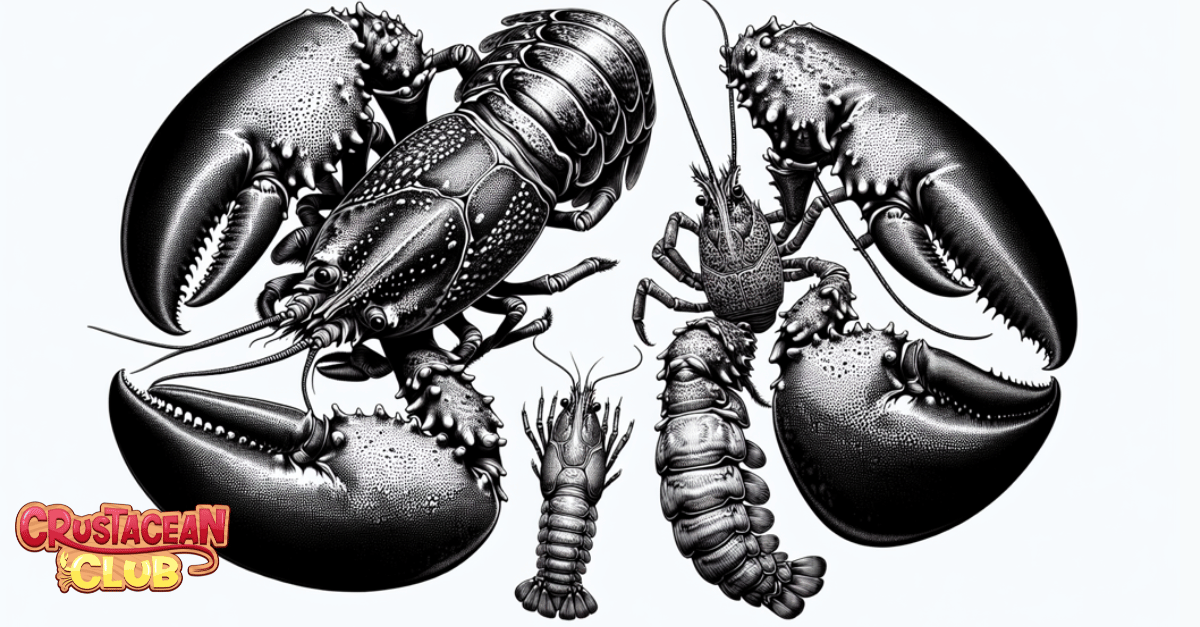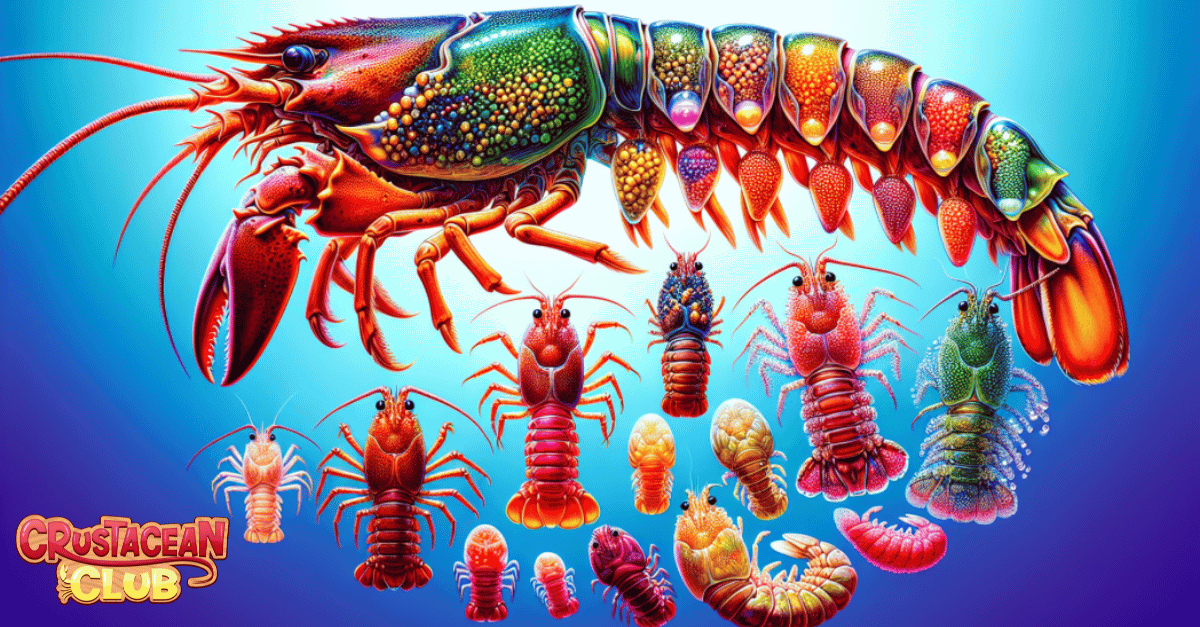Determining a lobster’s gender is straightforward once you know the signs to look for. This guide provides a clear rundown on how to distinguish a lobster female or male using simple visual clues. Without delving into the finer points of marine biology or gourmet cuisine just yet, you’re about to discover the essential traits that reveal a lobster’s sex, preparing you for culinary choices or simply satisfying your curiosity.
Check out the Crustacean Club site for additional information on all things lobster!
Key Takeaways
- To tell if a lobster is male or female, check the swimmerets: rigid and bony for males, soft and feathery for females, rather than relying on claw size.
- Female lobsters have wider tails to carry and protect their eggs, and when filled with roe, it’s considered a delicacy for its unique flavor in cooking.
- Beyond anatomy, lobsters have complex life cycles starting with females carrying up to 100,000 eggs and engaging in distinct courtship rituals, and while gender does not significantly affect taste, both are prized for their sweet, succulent flavor. Learn more about everything lobster in our expert guides.
We love hearing from our readers and subscribers, so please feel free to reach out and contact us today!
Deciphering Lobster’s Gender: A Guide for Curious Minds
Identifying a lobster’s gender is more than just a cool party trick for your next seafood feast. It’s a peek into the fascinating world of these sea creatures, a world where size, shape, and subtle physical traits literally define who’s who. And the best part? You don’t need a degree in marine biology to tell a male lobster from a female. All you need are some keen observation skills and a pinch of curiosity.
Before diving in, it’s essential to familiarize ourselves with the subjects at hand. It turns out, the differences between male and female lobsters aren’t as cryptic as you might think. Physical features such as claw size and the structure of swimmerets are key distinctions between the two genders. With a keen focus on these attributes, one can easily determine a lobster’s gender.
Claws and Size Matters
Now, you might have heard that lobsters with larger claws are males. It’s a popular belief, I must admit. But is it entirely accurate? Not quite. While larger claws are often seen on male lobsters, claw size is not a definitive method for determining the gender of a lobster.
Hence, relying solely on claw size as a gender marker might lead to incorrect conclusions.
Swimmerets: The Tell-Tale Signs
If not claws, then what serves as a reliable marker? Let’s shift our attention to something a bit less obvious: swimmerets. These tiny appendages beneath the lobster’s tail are not just for swimming. They’re an integral part of identifying the sex of a lobster due to their distinct shape and texture in each gender. It’s like nature’s own little gender reveal party.
To determine if a lobster is male or female, one must examine their swimmerets. Males exhibit rigid, bony first pair of swimmerets, which can be easily felt and observed upon inspection. These are known as the male’s swimmerets. Females, on the other hand, have first pair of swimmerets that are thin, feathery, and soft, setting them apart from their male counterparts. Hence, a close examination of the swimmerets provides a reliable clue to a lobster’s gender.
The Tail Tale: Spotting the Female Lobster
Having discussed claws and swimmerets, it’s time to focus on another distinguishing trait: the tail. If you’ve ever compared a group of lobsters side by side, you might have noticed some variation in tail size and shape. This isn’t just a random occurrence but a significant gender marker.
Female lobsters possess a female’s larger tail, also known as a female’s tail, as an adaptation to accommodate the storage and carrying tens of thousands of eggs. This enlarged tail serves a crucial role in not only carrying eggs but also in protecting them until they are ready to hatch. Therefore, spotting a lobster with a wide, slightly curved tail usually signifies a female.
The Role of Roe
Since we’re on the topic of eggs, it’s pertinent to discuss roe. Roe, or lobster eggs, presents as dark green, grain of rice-sized, and irregularly shaped clusters under the female’s tail. But these tiny eggs are more than just future baby lobsters. They’re a culinary treasure.
Lobster roe is often used to enhance the taste of sauces, soups, and seafood dishes due to its rich, creamy texture and briny flavor. Compared with other caviars, lobster roe has a sweeter and less salty taste, contributing to its consideration as a delicacy in culinary circles.
Therefore, encountering a female lobster with roe is not just a marine biology experience, but a culinary opportunity as well.
Lobster Life Cycle: From Eggs to Adults
Having learned to distinguish between male and female lobsters, it’s time to delve into the remarkable life cycle of these captivating marine creatures. It begins with a female lobster laying up to 100,000 eggs, which she carries under her tail attached to her swimmerets for 9 to 12 months, before the hatchlings, or naupliosoma, are released into the water.
Once released, the hatchlings embark on a journey of transformation. They go through multiple growth stages including a phyllosoma stage that consists of 11 sub-stages, during which they can drift up to 1000 km from the coastline over 18-24 months. Following the phyllosoma stage, lobster larvae enter the Puerulus stage, resembling small, transparent juveniles, using stored fats to survive and are capable swimmers, traveling up to 150 km to the shore before they settle.
Once settled on the seafloor, these juveniles mature into the lobsters we recognize after 4-5 years. It’s a journey that is as captivating as the creatures themselves.
To find spots to observe all the stages of the lobster life-cycle and see their different stages of transformation, be sure to check out Crustacean Club’s Hot Spot Locations list to learn about the best lobstering locations in Florida.
Courtship and Mating Rituals
But no life cycle is complete without a little romance. And lobsters, despite their hardened exterior, have a rather interesting courtship and mating ritual. It all starts with the female lobster using pheromones to attract males by urinating the pheromones at the entrance of their dens. Talk about a unique way to woo a mate!
The courtship extends from a brief encounter to several days, culminating in a belly-to-belly embrace before the male and female overturn with the latter positioned above. Following the mating, female lobsters store the sperm within specialized structures called rectangular shields located between their walking legs. This stored sperm can remain live and be used for fertilization for up to two years. It’s a complex dance of nature that ensures the continuation of their species.
Culinary Considerations: Does Gender Affect Taste?
Given these distinctions, one might ask if male and female lobsters differ in taste. It’s a common question. The taste of a female lobster may differ from that of a male if she still contains her eggs. However, when female lobsters do not contain roe, their tails have the same overall flavor as those of male lobsters.
The gender of the lobster does not significantly affect its taste, as both male and female lobsters are known for their sweet and succulent flavor, influenced more by size, diet, and cooking method.
Regardless of gender, be sure to access our library of recipes to learn new ways to create a sumptuous lobster meal!
Selecting Shellfish for Your Table
Equipped with this knowledge, you may be enthusiastic about purchasing lobsters for a culinary experiment. But before you do, there are a few things to keep in mind. When selecting live lobsters suitable for cooking, look for active movements in their legs and claws. They should also curl their tails when picked up.
Once you’ve made your selection, store your live lobsters in the refrigerator within the crisper drawer, covered with damp newspaper and with bands secured around their claws. And when it’s time to cook, remember to use a humane method. Freezing the lobster for 30 to 60 minutes followed by immersing it head-first into boiling water is recommended.
With these tips, home cooks can confidently select and prepare lobsters for their next culinary adventure.
Lobster Legwork: Walking Legs and Body Shape
Beyond claws, swimmerets, and tails, a lobster’s walking legs and body shape can also indicate its gender. Here are some key differences between a male and female lobster:
- Male lobsters possess walking legs with a hard shell, indicative of their gender.
- Female lobsters have more delicate and feathery walking legs, setting them apart from males.
- Additionally, the tail shape varies, with male lobsters having straight tails and females having wider tails with a slight curve.
So, when it comes to lobsters, every feature counts.
Serving Up Science: Understanding Lobster Anatomy
Grasping lobster anatomy can be compared to assembling a complex jigsaw puzzle. Every part, from the largest claw to the tiniest swimmeret, plays a role in the creature’s overall function and identity. The anatomy of lobsters is structured into modules comprising:
- The carapace (main body shell)
- The pleon (abdomen or tail)
- The chelipeds (claws)
- The pereiopods (legs)
Among these, swimmerets serve roles in swimming, stabilizing and righting their body, creating water currents, and aerating eggs, while extra fins provide additional support.
Beyond the Tail and Claws
Beyond the frequently highlighted tail and claws, the lobster’s carapace also serves as a gender indicator. The shape of a lobster’s carapace is one of the anatomical traits that can indicate its gender.
Carapace shapes in lobsters can vary significantly, ranging from elongated forms to those that are transversely ovate. An elongated carapace is more stretched out, while a transversely ovate carapace is broader and rounded. Distinguishing between these carapace shapes helps in accurately determining the gender of lobsters, beyond the traditional methods of examining the tail and claws.
Summary
We’ve dived deep into the world of lobsters, exploring everything from their distinguishing features to their life cycle, mating rituals, and even their culinary value. We’ve learned that the size of a lobster’s claws doesn’t definitively indicate its gender, but rather a combination of features including swimmerets, tail shape, and walking legs provide more accurate clues. Moreover, we’ve discovered that the gender of a lobster doesn’t significantly affect its taste, debunking a common culinary myth.
With this newfound knowledge, you’re now well-equipped to discern between a male and female lobster, whether you’re at a fish market, a seafood restaurant, or even on a lobster boat. So the next time you encounter these fascinating creatures, take a moment to appreciate their complexity and marvel at the wonders of the natural world. From the lobsters’ ocean floor to your dining table, it’s a journey filled with discovery and delight.
Learn more about us and the wealth of knowledge we have to offer here at Crustacean Club about all things, well, crustacean!
Frequently Asked Questions
Can lobsters have both genders?
Yes, split-color lobsters can have both male and female characteristics, making them gynandromorphs. So, technically, they can have both genders.
How can I tell if a lobster is male or female?
You can tell if a lobster is male or female by examining its swimmerets, tail shape, and walking legs. Male lobsters have rigid, bony swimmerets and straight tails, while female lobsters have thin, feathery swimmerets and wider tails with a slight curve.
Do male and female lobsters taste different?
No, male and female lobsters do not taste different. Their taste is more influenced by factors like size, diet, and cooking method. So, you can enjoy both without noticing a significant difference in taste.
What is lobster roe and how does it taste?
Lobster roe, also known as lobster eggs, is a culinary delicacy found in female lobsters. It has a rich, creamy texture and a briny flavor that is sweeter and less salty compared to other caviars. It’s a delicious addition to seafood dishes.
How do lobsters mate?
Female lobsters attract males with pheromones and then engage in a belly-to-belly embrace before mating. After mating, female lobsters can store sperm for up to two years in specialized structures called rectangular shields.
Hi! My name is Jessica, and I am the Head of Content for Crustacean Club. If you woul like any changes or if you want to submit a blog, DM me!





















